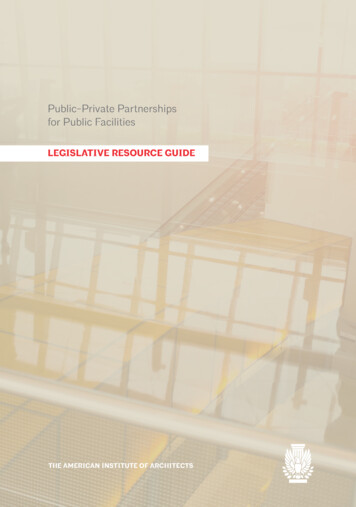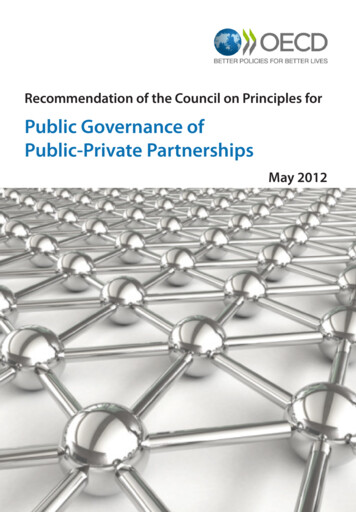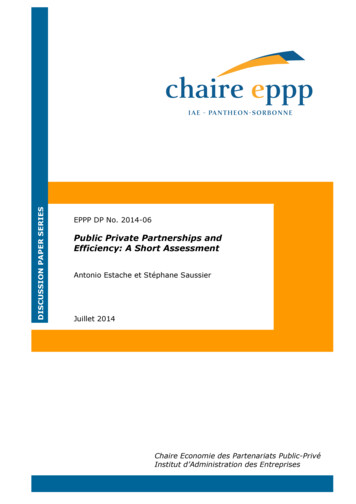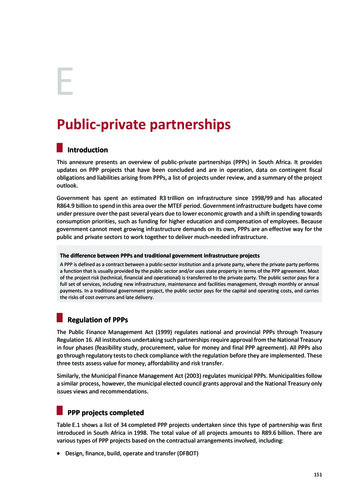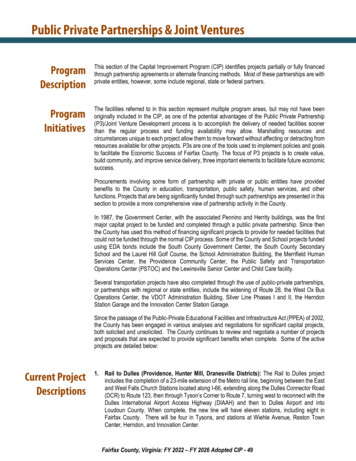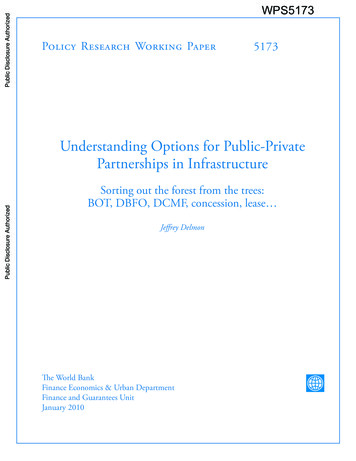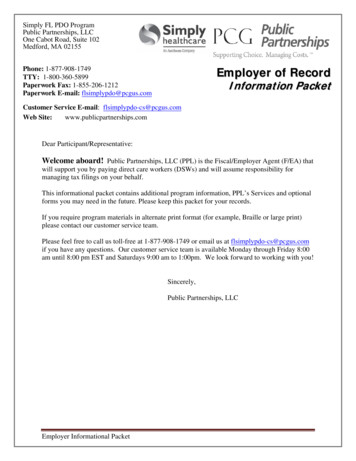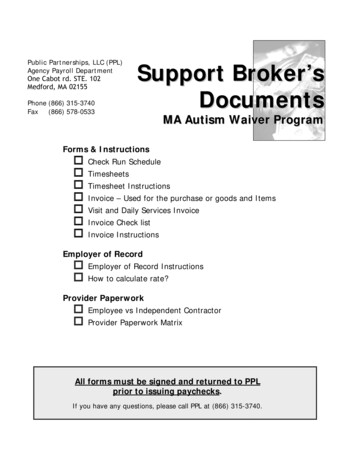
Transcription
Using public-privatepartnerships to advancesmart citiesPart two: Funding andfinancing smart cities seriesDeloitte Center forGovernment Insights
Using public-private partnerships to advance smart citiesAbout the authorsTiffany Dovey FishmanTiffany is a senior manager with theDeloitte Center for GovernmentInsights. Her research and client workfocuses on how emerging issues intechnology, business, and societywill impact organizations. She haswritten extensively on a wide range ofpublic policy and management issues,including infrastructure and smartcities. She is the author of Partnering forvalue: Structuring effective public-privatepartnerships for infrastructure, The riseof mobility as a service: Reshaping howurbanites get around and Smart mobility:Reducing congestion and fostering faster,greener, and cheaper transportationoptions. Her work has appeared in anumber of publications, including PublicCIO and Governing.Michael FlynnMichael Flynn is the Global FinancialAdvisory Public Sector Leader forDeloitte. He also leads the Deloitte EMEAInfrastructure & Capital Projects practiceand focuses on advising public, privateand backing sector clients on financeraising, restructuring and refinancing ofboth project finance and corporate debttransactions including the developmentof government and infrastructure assets,real estate, energy, and renewable energyassets. This advice has included theincorporation of ‘smart’ into traditionalinfrastructure and considering valuecapture opportunities including assetrecycling for government clients.About the Deloitte Centerfor Government InsightsThe Deloitte Center for GovernmentInsights shares inspiring stories ofgovernment innovation, looking atwhat’s behind the adoption of newtechnologies and managementpractices. We produce cutting-edgeresearch that guides public officialswithout burying them in jargon andminutiae, crystalizing essential insightsin an easy-to-absorb format. Throughresearch, forums, and immersiveworkshops, our goal is to providepublic officials, policy professionals,and members of the media with freshinsights that advance an understandingof what is possible in governmenttransformation.Michael is a member of the United NationsEconomic Commission for Europe (UNECE)PPP Business Advisory Board and theInternational Project Finance AssociationCouncil in Ireland. Michael is a member ofthe Deloitte Insights board.2
Using public-private partnerships to advance smart citiesIn 2007, for the first time in human history,more people lived in urban areas thanrural ones. Fast forward to today andgrowing urbanization patterns show fewsigns of abating. An estimated 3 millionpeople move to cities every week. By 2050,city dwellers are expected to outnumbertheir rural counterparts by a ratio of 2:1.Saddled with legacy infrastructure andlimited budgets, many urban areas arestruggling to keep pace with such rapidgrowth. The result is increased congestion,reduced quality of life, lost economicpotential, and negative health outcomes.Cities around the world are increasinglylooking to implement initiatives thatrespond to these challenges. But limitedfunds constrain progress. Just 16 percentof cities are able to self-fund requiredinfrastructure projects. As a result, citiesare enlisting the support of private andnon-profit partners to advance their smartcity agendas.In this article, we examine the creativeways municipalities are using private andnon-profit sector participation to advancetheir smart city agendas and distill thelessons learned for other cash-strappedcities seeking to overcome their ownfunding and financing barriers.3
Using public-private partnerships to advance smart citiesPartneringfor smart cityinitiativesFrom initiatives aimed at improving public health and expanding Wi-Fi access topromoting affordable housing, municipalities are forging innovative partnershipsto improve the quality of life for their residents and as a means of refurbishingand modernizing aging infrastructure assets. Their experiences show how citiescan overcome traditional barriers to funding and financing smart city projectsby demonstrating new technology’s potential to reduce costs, recycling existingand legacy infrastructure assets, unlocking value, and bringing a critical mass ofplayers together to spur economic development.4
Using public-private partnerships to advance smart citiesLeveraging privatemarket value inLouisville, KYLouisville, Kentucky had gained a reputationas one of the worst cities for breathingdisorders. To attack that problem, the citydeveloped AIR Louisville, a public-privatepartnership that uses data analytics toinform the public on triggers that aggravateasthma. The initiative used private grantsin its early phases for funding. Since then,technology purchases by private companiesthat stand to benefit from the initiative haveallowed AIR Louisville to expand further.AIR Louisville initially developed from apartnership among : The City of Louisville Propeller Health The Institute for Healthy Air, Water and Soil Local employers Healthcare providers Local advocacy groupsThe technology behind the project is asensor that attaches to an asthma inhaler.Propeller Health manufactures the sensors,which collect data about the surroundingenvironment each time an individual usesthe inhaler. Consumers can view reportingdata through a smartphone app. The usercan then better identify personal respiratorytriggers—time of day, location, temperature,pollen count, and pollution. This data is alsocommunicated to healthcare providers,enabling them to tailor a personalized planfor managing participants’ asthma andchronic obstructive pulmonary disease.In its first year, AIR Louisville helpedparticipants to reduce their asthma rescueinhaler use by 82 percent, more than doubletheir number of symptom-free days, andgain increased control of their asthma forthose with uncontrolled asthma at theoutset of the pilot.Propeller Health aggregates the datagathered from all the sensors in use andprovides this to the city under an agreeddata sharing plan. The city uses this datato create a map of asthma risk for eachneighborhood in Jefferson County. This mapis used to inform various initiatives aimed atimproving air quality in the county’s asthmahotspots—everything from increasingtree coverage and identifying alternativetruck routes to reduce diesel emissions, toconsiderations of city-wide zoning changesto reduce the health impacts of highwaysand industrial emissions.Dr. Ted Smith, Chief Innovation Officerfor the city of Louisville, collaboratedwith Propeller Health to develop the datasharing plan. He arranged for private localphilanthropies to purchase 300 sensorsfrom Propeller Health for free distribution tocity residents. This proof-of-concept phaseconfirmed that the anonymous data sharedwith the city could inform the public aboutthe status of the environment using toolssuch as a heat map.In the second phase, the city approachedthe Robert Wood Johnson Foundation(RWJF) for additional funding. The usefulnessof the aggregated data correlated directlywith how many sensors operated in thecity. The RWJF supported AIR Louisville witha 750,000 grant to acquire an additional2,000 sensors. The grant stipulated that AIRLouisville would track the healthcare costsavings of individuals who used the sensors.In phase three, area companies receivedthe health cost savings research. Sincecompanies have an incentive to reducehealthcare costs, they have begun topurchase Propeller Health sensors,providing them to employees who needthem as part of their health plans. Withthe data sharing plan still in place, the citybenefits from additional deployed sensorswithout purchasing the devices directly.Giving asthma sensors to employees willhelp employers save money on healthcarecosts. Once the private grant money hasbeen depleted, it is anticipated that theprivate market will sustain the purchaseand use of the sensors technology. As thenumber of deployed sensors grows, sowill the data pool the city draws upon tosupport policy decisions, increasing thevalue of its analytics.Many other cities could benefit from aproject like AIR Louisville. Based on datafrom roughly 3,000 cities, nearly 80 percentof people living in urban areas are exposedto air pollution that exceeds World HealthOrganization recommendations. Thatexposure increases the risk of a varietyof respiratory diseases, heart disease,stroke, and lung cancer. In the OECDalone, between 2005 and 2010, ambientair pollution caused nearly a half milliondeaths. Based on Louisville, success in thiscase is built around a collaboration betweenthe public and private sectors with bothbenefiting from the data collection, social/health benefits, and cost savings.5
Using public-private partnerships to advance smart citiesAsset recyclingin New York Cityand TorontoAs the rise of smart phones started tomake payphones obsolete, New York Cityfaced a problem—an aging network of8,400 public phones that attracted fewerand fewer users. Despite the pay phoneshaving reduced usage, the phone boothsstill generated substantial revenues for thecity. By serving as billboards for advertisers,they brought in just over 17 million in 2013.However the city recognized that the annualprofits were decreasing and the boothsalso presented problems: they frustratedresidents, blocked pedestrian traffic, andappeared anachronistic in the world ofmodern communications.In 2013, the New York City Departmentof Information Technology andTelecommunications (DoITT) requestedproposals to replace its aging payphones.The city awarded the contract to theCityBridge Consortium, a partnership thatincludes Qualcomm, Titan, and ControlGroup. Control Group and Titan havesince merged to form a company calledIntersection. Thanks to this partnership, in2014 New York City started replacing theobsolete payphones with smart kiosks—called “Links”—that provide free Wi-Fi, maps,transportation updates, video calls, devicecharging, and more. CityBridge pays forand operates the entire LinkNYC system atno cost to the city and offers the servicesto users free of charge, funded with thesupport from advertising revenues.CityBridge incurred an estimated 200million to install the Links. The city receives50 percent of the gross advertisingrevenue, or 17.5 million (whichever ishigher), from the CityBridge Consortiumeach year. When complete, 7,500 Links willbe installed, making it the most expansivesystem of Wi-Fi hotspots. The city predictsthat its share of advertising revenues willcome to 500 million over the initiative’sfirst 12 years.In addition to producing substantialincome for the city, LinkNYC is alsoexpected to create 100–150 full-time jobsand 650 support jobs once CityBridgeinstalls all the Links.While not every city has thousands ofpayphones to convert, this example pointsto the idea that cities may partner withprivate companies to convert or upgradephysical public assets in ways that increasethe value those assets provide.Toronto is taking this approach in an effortto revitalize part of the city’s waterfront.In 2016, Toronto identified a portion ofcity-owned lands along the waterfront thatit considered surplus and issued a requestfor proposals to prospective developers.The city ultimately sold the land, on Queen’sQuay, to a consortium of developers for 260 million.The terms of the sale call for thedevelopers to work with the city to createaffordable housing, public spaces, heritageconservation sites, and office towers thatwill include new headquarters for theLiquor Control Board of Ontario. The citywill use the 260 million to fund transitand transportation infrastructure projects.Other variants of this model have also beenused around the world from asset disposalsuch as Toronto to joint developmentpartners in other cities. The model used willdepend on the level of risk the city wishes toretain on the ultimate value generated forthe recycled asset.6
Using public-private partnerships to advance smart citiesUnlocking data valuein Kansas CityKansas City had already earned a reputationas one of the smartest cities in the U.S.when, in 2014, Cisco and Sprint approachedits government to propose a free public WiFi and interactive kiosk project. The partnerswould install 25 kiosks along the city’sdowntown streetcar route. Kansas City hadinstalled this new, 2.1-mile system to reducetraffic congestion and encourage greaterfoot traffic to downtown businesses.The city and the private partners reachedan agreement in June of 2015. By early2016, the city had installed all 25 kiosks.Citizens can use the kiosks to access theweb through their connected devices,free of charge. They can also interactwith kiosks to find information about cityservices, current events, transportation,local business information, local history,and entertainment. In addition, the kiosksoperate as an emergency alert system,enhancing public safety.Kansas City provided 3.7 million towardsthe overall capital cost of 16 million forthe project, taking the money from variousparts of the existing budget. The cityexpects to recoup its share of the capitalcosts by collecting advertising revenuefrom the kiosks. The city governmentshares advertising revenue equally withits advertising manager, Smart City Media.Kansas City expects to fully recoup itscapital costs in four to five years. Therevenue sharing model will then shift togive 25 percent to the city, while Smart CityMedia retains the rest.Cisco and Sprint supplied the remaining 12.3 million to cover hardware andmaintenance costs. The private investors donot receive any direct monetary return oninvestment. Instead, they receive exclusiveaccess to usage data from the kiosks. Sprinthas used the collected Wi-Fi data to test theviability of expanding its Wi-Fi coverage toother areas of the city.The kiosk project is one example of howKansas City hopes to use big data togenerate benefits for taxpayers. While Ciscoand Sprint take advantage of usage datacollected from the kiosks, the city will usedata from other smart city projects to makeits operations more efficient. City workerswill have the ability to quickly respond tomaintenance requests for streets, waterlines, and other infrastructure. Big datacurrently supports live maps, which willallow commuters to find available parkingquickly and easily.Many companies seek ways to gain accessto data beyond their current customerbases. Kansas City illustrates how cities canuse data collection to incentivize privateinvestment in projects that create value forcitizens. Most cities either already have awealth of valuable data or have the capacityto facilitate its collection. With thoughtfullynegotiated security and contract terms,a city’s residents can benefit from freeinternet access, and companies can benefitfrom the abundance of user data theseprojects provide.7
Using public-private partnerships to advance smart citiesForce multiplier effectin ColumbusIn 2016, the U.S. Department ofTransportation awarded Columbus, Ohio, 50 million as the winner of its “SmartCity Challenge.” Columbus prevailed overmore than 77 other applicant cities forthis award. The Columbus proposal for thegrant had a holistic vision: improve accessto jobs through expanded mobility, improveneighborhood safety, provide reliabletransportation, and adopt environmentallysustainable development methods.Winning the challenge helped reinforceColumbus’ Smart City plans and attractedmore 360 million in private investment forits Smart Columbus Acceleration Fund. Thefund will support Smart City initiatives citywide. Columbus’ plans include initiativesin transit, employment opportunities, andenergy sustainability.Columbus started developing strategicpartnerships with private entities while itwas still contending for the Smart Citiesgrant. The Columbus Partnership—anon-profit comprised of 65 Columbusarea CEOs—pledged financial support toincrease project viability and demonstratecommunity support for the initiative.Private partners inside and outside of Ohiohave continued to contribute to the SmartColumbus Acceleration fund, includingCardinal Health, Drive Capital, AT&T, andHonda.When the DOT awarded the grant toColumbus, it minimized risk for businessesinterested in contributing funds. Privatepartners were more inclined to donate, sincethe grant indicated that the Smart Columbusinitiative was viable, well-developed, andlikely to succeed.Some partners receive direct benefits fromtheir contributions in the form of user feesand cost savings. Others will not receivea direct return on investment but haveembraced the indirect benefits, stating thatwhen the city thrives, business will too.Columbus’ success in the DOT Smart CityChallenge brought it national attention.But other U.S. cities not specifically seekinglarge federal or private grants can useColumbus’ strategy of building an innovationecosystem. While the federal grant helpedto attract additional support, the localpledges of financial support served as aforce multiplier as well.This type of ecosystem developmentenhances the power and credibility ofa city-directed implementation modelfor smart city projects. Rather than cityleaders directing initiatives through theusual procurement relationships, theycan encourage diverse stakeholders toparticipate in the preliminary stages. Thisstrategy increases the odds that largeprivate investors will see potential in thecity or that the city will be a contender forlarge grants. Similar grants available to citiesinclude the IBM Smarter Cities Challenge,National Science Foundation, 100 ResilientCities from the Rockefeller Foundation,and the Innovation Teams from BloombergPhilanthropies.8
Using public-private partnerships to advance smart citiesGetting startedWhatever kind of smart city initiative a localgovernment pursues, several key practicescan set the stage for successful publicprivate collaborations. Here are a few waysto foster productive partnerships:Start with the end in mind.Define the desired outcomes at the outsetof the project. Getting clarity around theultimate objectives you’re trying to achieveand the needs you’re trying to address is anecessary first step.Inventory your available assets.Take stock of the assets you have at yourdisposal. Are there particular assets thatcould be recycled? If so, are you permittedto recycle the asset or are there barriers totransferring ownership or management ofthe asset? Once a public sector entity hasestablished what it’s permitted to do, thenext step is understanding the relative valueof the assets to both the city and to theprivate sector.Understand the business model.What is the proposed revenue model? Whatare the related business risks? Projects needto be financially sustainable, which, in somecases, may require scale beyond your city.Appoint a champion with cleardecision-making authority.A clear decision-maker, often a chiefinnovation officer or equivalent leader,within city government can streamlineplanning and aid in building keyrelationships. The city-led approach assistsin project implementation by establishing apublic champion to act as a face for the city.Build local support.When smart city projects have local support,cities are better positioned to attract privatepartners. Residents embrace projects thathave clear social benefits and such projectsappeal to businesses’ social responsibilitygoals. The likelihood of receivingphilanthropic support improves when theproject serves the needs of a populationand aligns with a private partner’s mission.In the case of Columbus, the city prioritizedassisting underserved residents and thebusiness community’s pledge served as avote of confidence which helped to securethe DOT grant. AIR Louisville’s project aimedto improve the health of the residents,attracting support from the RWJ Foundation.LinkNYC and Kansas City’s Wi-Fi kiosksprovide a free, convenient service to touristsand residents.Develop a business case that clearlylays out the value to potential partners.A city must present a business case thatclearly articulates the potential value of theproject to private partners. The value cantake different forms, from direct returns oninvestment to indirect benefits like greatereconomic development. With LinkNYC, theCityBridge Consortium received direct valuein the form of advertising revenue. In KansasCity, Sprint contributed in order to accessprofitable usage data. For Columbus, whilemany businesses will not receive a directreturn, the improvements to the city indicatefuture financial gains for the private sector.AIR Louisville saved participating firms anaverage of 930 per year for each asthmaticemployee.Create a third-party entity.Establishing a third-party entity encouragesrole clarity, political feasibility, and easesprocurement. A third-party entity can helppartners and cities navigate the complexstructure of both city governments andprivate corporations. Columbus reliedon the Columbus Partnership to raisesignificant funding for the initiative. LinkNYCdelegated the operations of the Linksto the CityBridge Consortium. Louisvilleestablished AIR Louisville to coordinate thetransfer and analysis of complex healthdata. Third parties provide a clear platformfor decision-making and planning.9
AcknowledgementsContactsA number of colleagues within Deloittemember firms generously contributedtheir time and insights to this report. Inno particular order, the authors wouldlike to thank Melissa Brasel, KimberlyMetzger, and Amit Golder. John O’Learyand David Noone from the DeloitteCenter for Government Insights providedvaluable inputs and critical editorial helpat important junctures.John SkowronPrincipalDeloitte Consulting LLP 1 412 402 5228jskowron@deloit te.comMichael FlynnPartnerDeloitte Consulting LLP 353 1 417 2515micflynn@deloit te.ieThis document contains general information only and Deloitte is not, by means of this document, renderingaccounting, business, financial, investment, legal, tax, or other professional advice or services. This document isnot a substitute for such professional advice or services, nor should it be used as a basis for any decision or actionthat may affect your business. Before making any decision or taking any action that may affect your business, youshould consult a qualified professional advisor. Deloitte shall not be responsible for any loss sustained by anyperson who relies on this document.Deloitte shall not be responsible for any loss sustained by any person who relies on this publication.About DeloitteDeloitte refers to one or more of Deloitte Touche Tohmatsu Limited, a UK private company limited by guarantee(“DTTL”), its network of member firms, and their related entities. DTTL and each of its member firms are legallyseparate and independent entities. DTTL (also referred to as “Deloitte Global”) does not provide services to clients.In the United States, Deloitte refers to one or more of the US member firms of DTTL, their related entities thatoperate using the “Deloitte” name in the United States and their respective affiliates. Certain services may not beavailable to attest clients under the rules and regulations of public accounting. Please see www.deloitte.com/aboutto learn more about our global network of member firms.Copyright 2018 Deloitte Development LLC. All rights reserved.Tiffany FishmanSenior ManagerDeloitte Consulting LLP 1 571 882 6247t fishman@deloit te.com
technology, business, and society will impact organizations. She has written extensively on a wide range of public policy and management issues, including infrastructure and smart cities. She is the author of Partnering for value: Structuring effective public-private partnerships for infrastructure, The rise of mobility as a service: Reshaping how
